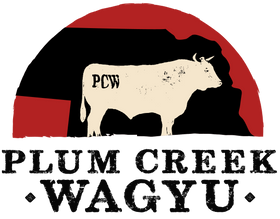The Origins and Types of Wagyu
Wagyu, translating to 'Japanese cow', refers to specific breeds of cattle in Japan, including the Japanese Black, Japanese Brown, and Japanese Shorthorn. Among them, the Japanese Black breed, known for producing the famed A5 Wagyu, is particularly celebrated for its extraordinary marbling. Wagyu has now found a home outside Japan as well, with American Wagyu and Australian Wagyu emerging as popular varieties, developed by cross-breeding Japanese Wagyu cattle with domestic breeds.

Japanese Wagyu and Kobe Beef
Japanese Wagyu is renowned for its strict breeding methods and feeding techniques, resulting in beef with unparalleled marbling and flavor. Kobe beef, a type of Japanese Wagyu from the Hyogo Prefecture, is one of the most prestigious and sought-after varieties. It's known for its tender texture, flavor, and well-distributed intramuscular fat.
American Wagyu
The American Wagyu Association oversees the breeding of Wagyu in the USA. American Wagyu, often a cross between Japanese Wagyu and Angus cattle, offers a different but equally exquisite taste profile, balancing the marbling of Wagyu with the bold flavors of American beef.
Health Aspects of Wagyu
Wagyu beef's marbling is not only about taste but also includes health benefits. It's rich in monounsaturated fats, particularly oleic acid, and lower in saturated fats compared to regular beef. This composition contributes to a healthier profile of fatty acids in Wagyu.
Wagyu's Unique Marbling
The marbling in Wagyu is what sets it apart. This fat composition gives Wagyu its buttery flavor and tender texture. Unlike the fat in regular beef, Wagyu's marbling melts at a lower temperature, providing a unique taste experience.

Raising Wagyu
Wagyu farmers in Japan and elsewhere follow strict guidelines to raise Wagyu cattle. The process includes specialized feed and care to ensure the highest quality of meat. Wagyu genetics play a significant role in the beef's quality, with Wagyu farmers focusing on preserving these unique traits. Learn more about raising Wagyu & their feeding practices.

Wagyu in Cuisine
Wagyu's versatility makes it a favorite in both Japanese and Western cuisines. Wagyu steak is a popular way to enjoy this meat, allowing the natural flavors to shine through. In Japan, Wagyu is often prepared in traditional dishes, offering a distinct flavor that's celebrated globally.
This versatile meat is celebrated for its ability to adapt to various cooking styles and dishes, making it a prized ingredient in the global culinary scene.
Wagyu in Western Cuisine
- Grilled Wagyu Steaks: In Western cuisine, grilling is a popular method to prepare Wagyu steaks. Cuts like Ribeye, New York Strip, and Sirloin are grilled to perfection, allowing the natural marbling to add depth and richness to the flavor.
- Roasted Wagyu: Larger cuts of Wagyu, such as the Chuckeye roast or Tenderloin, are often oven-roasted, creating a luxurious centerpiece for special occasions.
- Wagyu Burgers: Ground Wagyu beef makes for an indulgent upgrade to the classic burger. The rich marbling in the meat ensures a juicy, flavorful patty that's a cut above the typical beef burger.
The Role of Wagyu Steaks in Different Cuisines Each type of Wagyu steak brings something unique to the table:
- Wagyu Ribeye: Known for its incredible marbling and tenderness, Wagyu Ribeye is a favorite in both Japanese and Western cuisines. It's often grilled or pan-seared to highlight its rich, buttery flavor.
- Wagyu Sirloin: A leaner cut, Wagyu Sirloin is versatile and can be prepared in a variety of ways, from quick grilling to slow roasting.
- Wagyu Tenderloin: The most tender cut, Wagyu Tenderloin is a premium choice for special dishes. Its delicate flavor and buttery texture make it a sought-after cut for fine dining experiences.

The story of Wagyu is one of heritage, quality, and excellence. Each cut of Wagyu beef embodies the dedication of its farmers and the rich history of Japanese cattle rearing which results in its marbling and flavor to its health benefits and cultural significance. As Wagyu continues to charm food enthusiasts around the world, it remains a testament to the dedication of Wagyu farmers and the rich history of Japanese cattle rearing.
Related Posts
Sustainability in Wagyu Ranching: How Plum Creek Wagyu is Committed to the Environment
Explore how Plum Creek Wagyu is committed to sustainability with practices like rotational grazing, water conservation, humane treatment of cattle, and more. Learn about our efforts to produce high-quality beef while protecting the environment.
Wagyu Beef vs. Angus Beef: A Flavor Showdown
Discover the differences between Wagyu beef and Angus beef in this comprehensive showdown. Learn about flavor, texture, and the overall eating experience to determine which premium beef is right for you.
Wagyu Beef Recipes for Every Season: From Summer Grilling to Winter Braising
Explore seasonal Wagyu beef recipes perfect for any time of the year. From summer grilling to cozy winter braises, discover easy and delicious ways to incorporate premium Wagyu into your meals.
Health Benefits of Wagyu Beef: Why It's a Premium Choice
Discover the health benefits of Wagyu beef, from its heart-healthy monounsaturated fats to its higher levels of omega-3 fatty acids and CLA. Learn why Wagyu beef is a premium choice for those seeking a flavorful yet healthier alternative to traditional meats.
Pairing Wagyu Beef with Wines: A Guide to the Perfect Match
Discover expert tips on pairing Wagyu beef with the perfect wines. From Ribeye to Filet Mignon, explore the best wine matches to elevate your dining experience and make every bite of Wagyu beef unforgettable.
The History and Origins of Wagyu Beef: From Japan to Nebraska
Explore the rich history of Wagyu beef, tracing its origins from ancient Japan to the modern-day farms of Nebraska. Learn about the unique breeding practices and cultural significance of Wagyu, and discover how Plum Creek Wagyu brings this exceptional beef to your table.







